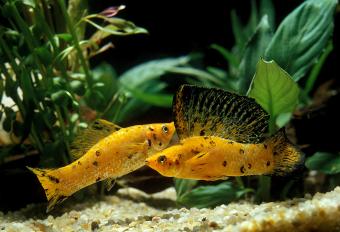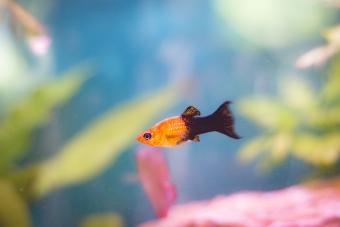
Mollies are related to another popular fish, the guppy. And they have similar needs and care requirements. They're known for their friendly demeanor and desire for exploration. You'll often see molly fish swimming around the tank checking out new places and interacting with other fishes.
Molly Fish Care Guide
Like other fish, freshwater or saltwater, Mollies require clean, fresh water and a good filtration system. They do well in community tanks and thrive in groups.

Molly Appearance
Mollies have rectangular bodies, with females appearing larger by the tail end. Males are often described as shaped like a torpedo. Black mollies are completely black, like their name implies. Sailfin mollies can come in several colors and patterns and are known for their prominent dorsal fin.
You’ll also find mollies in colors like red, white, gold, orange, platinum, and green. They can also have patterns like marble and dalmatian. Mollies can also have different tail shapes like guppies, such as round, lyre, and moon tail. There are also mollies with a short body known as balloon mollies.
Molly Lifespan and Health
Mollies live, on average, three to five years. They are known for getting the shimmies or molly disease, which is caused by stress and water that's too cold for them. Mollies can also get other common fish ailments like velvet, fin rot, swim bladder disease, and ich.
Choosing the Aquarium for Proper Molly Care
You'll want at least a 20-gallon tank for these social swimmers. Anything smaller, and your fish won't have the room they need to swim freely. Plus, wouldn't you rather have a bedroom than a closet? The same goes for our fish. If you're planning on setting up a community setup with other friendly fish, search for an even larger aquarium. Here are some tips for setting up your aquarium, whether it's a community tank or just the mollies.
- Gender: Don't overwhelm the tank with male fish. A balanced gender ratio can help keep the peace.
- Diet: Make sure all the species in your community aquarium have similar dietary needs. Some fish may need specialized food, while others are happy with generic flakes or pellets.
- The bigger the better: A small tank can lead to overcrowding, stress, and poor water quality — all recipes for disaster.
- Species: Some fish are peaceful and get along with most other species, while others can be territorial or even aggressive. Do your research before combining different fish species in the same tank.
Add a Good Quality Filtration System
When it comes to keeping your Molly fish happy and healthy, don't underestimate the power of a good filtration system. These little guys may be low-maintenance, but clean, well-circulated water is still a must. You'll want a filter that can handle both mechanical and biological filtration. Mechanical filtration removes physical debris — think uneaten food and fish waste — while biological filtration deals with harmful ammonia and nitrates.
For a molly-friendly aquarium, aim for a filter rated at least for the actual size of your tank. Filters like hang-on-back (HOB) or canister filters are generally solid choices for molly tanks. Just make sure to regularly check and clean or replace the filter media to keep everything running smoothly.
Like the size of the aquarium, the bigger the better. Filters designed for larger aquariums can be helpful, especially in community tanks.
Ideal Water Conditions for Mollies
You might think it's just water, but mollies have their preferences. Aim for a water temperature between 75° and 80°F (24° to 27°C). These tropical beauties love their water warm. They also prefer slightly alkaline water, so shoot for a pH range of 7.5 to 8.5. If you can manage it, they also appreciate a little aquarium salt in their water — just a teaspoon per gallon should do the trick. And don't forget about water hardness. Mollies like it moderately hard, so aim for a dGH between 10 and 25.
Regular water changes — about 25% to 30% every week — will keep your molly's aquarium healthy.
Testing Water Hardness
If you're like me, you're probably wondering how in the world you check how hard the water is. The easiest way to check water hardness is by using a commercial water hardness test kit. You can find these at any pet store or aquarium supply shop. These kits usually test for both General Hardness (GH) and Carbonate Hardness (KH). Follow the instructions on the kit, which typically involves adding a water sample to a test tube and then adding a reagent drop by drop until the color changes. Then you compare the results with the provided color chart. It's as simple as that.
Lighting for Your Molly Tank
Not only does proper lighting make your aquarium look like a dazzling underwater paradise, but it also helps regulate the life inside it. Mollies, like most fish, benefit from a regular day-night cycle. A good LED light can simulate natural daylight conditions. If you have live plants in your tank — which Mollies absolutely love — proper lighting will help them grow, adding another layer of health and beauty to your tank.
A hood is also recommended to prevent water evaporation and maintain a stable tank environment.
Add Gravel, Plants, and Accessories
This is where you can get super creative. Let your wild side fly free and have fun with this step. Here’s the order you should follow to make your tank as stable and beautiful as possible.

- Add the base: Start with a base layer of gravel or sand to add aesthetic appeal. It also provides a home for beneficial bacteria.
- Plants: Live plants not only give your tank a natural look, but they also offer hiding spots and help improve water quality.
- Accessories: Accessories like caves, driftwood, and fun decor add valuable hiding places to your fish tank.
If you're not ready to care for live plants, you can add in some artificial plants to provide hiding places.
Feeding Molly Fish
Mollies aren't picky eaters, but that doesn't mean you should just throw in any old fish food. A balanced diet is key to keeping these colorful swimmers happy and healthy. Start with a good quality flake or pellet food formulated for tropical fish. These are designed to provide the right mix of proteins, vitamins, and minerals for your fish species. In other words, don't feed goldfish flakes to your tropical fish — or vice versa.
Moderation is key. Overfeeding can lead to health problems and a messy tank. Aim to feed your mollies once or twice a day, and only give them as much as they can eat in a few minutes. Of course, this may take some trial and error at first, but once you know how much they eat in the first couple of minutes, you can dial down or add more as needed.
For a protein boost, you can also offer them live or freeze-dried foods like brine shrimp or bloodworms.
Molly Fish Personality Traits
Mollies are social butterflies. They thrive in groups, so if you have a Molly fish on their own, consider getting a few more to keep them company. You'll notice they're active and playful, often chasing each other around just for the fun of it. While they're generally peaceful fish, like us, they can have their moments. Some may become aggressive, nipping at tank mates or establishing a pecking order on occasion, but overall, they tend to keep to themselves and explore their environment.
Types of Mollies
There are a few species of mollies commonly found in aquariums. Most mollies have been interbred, so it can be hard to tell what their original species was.
Shortfin Molly

There are two types of shortfin molly: Poecilia mexicana and Poecilia shenops.
Poecilia sphensop is also known as the black molly and is among the most common species. These guys don't have the flashy fins like others do, but they do have quite the personality. They're known to be more energetic, dashing about the tank in playful spurts. These mollies can be entertaining to watch, especially if you're creating a tank for kids. They come in a variety of colors, from classic silver to vibrant orange, so you can really mix it up.
Sailfin Molly

The sailfin molly also has two types: Poecilia latipinna and Poecilia velifera. The velifera, or Mexican sailfin molly, is more difficult to find than the latipinna. Either way, you can think of these types as the peacocks of the fish world. They have large, ornate dorsal fins, which is what led to their name. As with most other fish species, the male is more radiant than the female. Sailfins come in an array of colors, from shimmering silvers to velvety blacks, and they absolutely love room to swim. A spacious tank allows them to really spread their fins, both literally and figuratively.
Liberty Molly

Poecilia salvatoris, also known as the liberty molly, is named for their red, white, and blue colors that resemble the American flag. This fish is a patriotic burst of color for any tank.
They're also quite hardy, tolerating a range of water conditions, which makes them a great choice for both beginners and seasoned aquarists. So, if you're looking for a fish that brings both color and character to your aquarium, check out this fish species.
Brackish Water Shortfin Molly

While many mollies are content in freshwater or saltwater, this one thrives solely in brackish conditions — a mix of fresh and salt water that mimics certain natural habitats like estuaries. Setting up a brackish tank might sound like a chore, but it's actually fun to make.
Brackish shortfin mollies, scientifically known as Poecilia gillii, have the same social, active traits as their freshwater relatives. And the slightly salty environment actually brings out the best in them. It's said to enhance their colors and boost their immune systems. In brackish conditions, these mollies also tend to be less susceptible to common fish diseases.
Swordtail Sailfin Molly

The swordtail sailfin molly, scientifically known as Poecilia petenensis, has the sail-like dorsal fin of the sailfin molly with an elongated tail that's reminiscent of a swordtail fish. The male's tails are significantly more decorative, adding even more flair to your tank. Like other molly species, they're social, active, and generally peaceful. They're also known to be hardy, thriving in both freshwater and brackish aquariums.
Molly Tank Mates
Mollies can live happily with other types of fish that are also peaceful. Some good common tank mates for mollies include:
Choosing the Molly Fish
If you're looking for a low-maintenance, social, and colorful addition to your aquatic family, then mollies are great pets! With proper care, these beauties can live up to five years, providing endless enjoyment and maybe even a few generations of mini-mollies.







